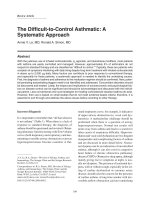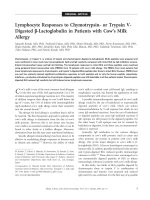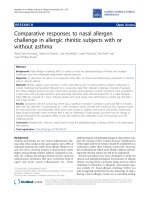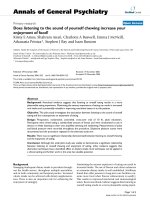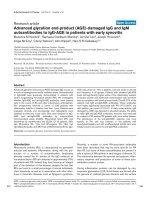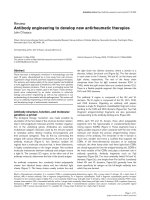Báo cáo y học: "Higher susceptibility to Fas ligand induced apoptosis and altered α modulation of cell death by tumor necrosis factor-α in periarticular tenocytes from patients with knee joint osteoarthritis" ppt
Bạn đang xem bản rút gọn của tài liệu. Xem và tải ngay bản đầy đủ của tài liệu tại đây (937.93 KB, 9 trang )
253
Introduction
Osteoarthritis (OA) is a chronic degenerative disorder of
the joints that affects a large proportion of the ageing
Western population. It is characterized primarily by the pro-
gressive destruction of articular cartilage, but it involves the
whole joint. Periarticular tendons are important functional
components of joints, and degenerative changes in
tendons increase significantly with age [1]. They show con-
siderable variability both with respect to their function and
distribution around the body. In some regions, such as the
shoulder, tendon degeneration may result in spontaneous
ruptures, whereas in other regions this is seen only rarely
[2]. The question regarding whether there is a specific rela-
tion between degenerative changes in periarticular tendons
and articular cartilage is incompletely understood. There is
evidence that joint instability promotes the development of
ELISA = enzyme-linked immunosorbent assay; FACS = fluorescence activated cell sorting; FasL = Fas ligand; FCS = foetal calf serum; FITC =
fluorescein isothiocyanate; OA = osteoarthritis; PCR = polymerase chain reaction; TNF = tumour necrosis factor; TNFRI = tumour necrosis factor
receptor I.
Available online />Research article
Higher susceptibility to Fas ligand induced apoptosis and altered
modulation of cell death by tumor necrosis factor-
αα
in
periarticular tenocytes from patients with knee joint osteoarthritis
Andreas Machner
1
, Anja Baier
1,2
, Aline Wille
3
, Susanne Drynda
2
, Géza Pap
1
, Andreas Drynda
2
,
Christian Mawrin
4
, Frank Bühling
3
, Steffen Gay
5
, Wolfram Neumann
1
, and Thomas Pap
2,5
1
Department of Orthopedic Surgery, Otto-von-Guericke-University, Magdeburg, Germany
2
Division of Experimental Rheumatology, Otto-von-Guericke-University, Magdeburg, Germany
3
Institute of Immunology, Otto-von-Guericke-University, Magdeburg, Germany
4
Institute of Neuropathology, Otto-von-Guericke-University, Magdeburg, Germany
5
Center of Experimental Rheumatology, University Hospital Zürich, Switzerland
Correspondence: Thomas Pap (e-mail: )
Received: 13 Feb 2003 Revisions requested: 19 Mar 2003 Revisions received: 15 May 2003 Accepted: 3 Jun 2003 Published: 30 Jun 2003
Arthritis Res Ther 2003, 5:R253-R261 (DOI 10.1186/ar789)
© 2003 Machner et al., licensee BioMed Central Ltd (Print ISSN 1478-6354; Online ISSN 1478-6362). This is an Open Access article: verbatim
copying and redistribution of this article are permitted in all media for any purpose, provided this notice is preserved along with the article's original
URL.
Abstract
The aim of the present study was to investigate the expression
of Fas in periarticular tenocytes of patients with osteoarthritis
(OA) and to study their susceptibility to Fas ligand-mediated
apoptosis. Tendon samples were obtained from the quadriceps
femoris muscle of patients with knee OA and used for
histological evaluation, for immunohistochemical detection of
Fas, and to establish tenocyte cultures. The expression of Fas
mRNA was determined by quantitative PCR. Levels of soluble
Fas and soluble tumour necrosis factor (TNF) receptor I were
measured using ELISA. Apoptosis was induced with
recombinant human Fas ligand and measured by a histone
fragmentation assay and flow cytometry. The effects of TNF-α
were studied by stimulation with TNF-α alone or 24 hours
before the induction of apoptosis. Tendon samples from non-
OA patients were used as controls. Histological evaluation
revealed degenerative changes in the tendons of all OA patients
but not in the controls. Fas was detected by immuno-
histochemistry in all specimens, but quantitative PCR revealed
significantly higher levels of Fas mRNA in OA tenocytes. In
contrast, lower levels of soluble Fas were found in OA tenocytes
by ELISA. OA tenocytes were significantly more susceptible to
Fas ligand induced apoptosis than were control cells. TNF-α
reduced the Fas ligand induced apoptosis in OA tenocytes but
had no effects on control tenocytes. These data suggest that
knee OA is associated with higher susceptibility of periarticular
tenocytes to Fas ligand induced apoptosis because of higher
expression of Fas but lower levels of apoptosis-inhibiting soluble
Fas. These changes may contribute to decreased cellularity in
degenerative tendons and promote their rupturing. The
antiapoptotic effects of TNF-α in OA tenocytes most likely
reflect regenerative attempts and must be taken into account
when anti-TNF strategies are considered for OA.
Keywords: apoptosis, osteoarthritis, Fas ligand, tenocytes, tumour necrosis factor-α
Open Access
R254
Arthritis Research & Therapy Vol 5 No 5 Machner et al.
osteoarthritic changes [3], and most recent data suggest
that abnormal composition of collagen fibrils in tendons
can result in development of OA [4]. As seen in clinical
studies, dysfunction of the quadriceps muscle is a common
and early feature of knee joint OA [5]. There is a close rela-
tion between muscle strength and tendon function. Some
data suggest that the changes in composition and histolog-
ical structure of collagen that occur in degenerated
tendons ultimately alter their biomechanical properties [6].
However, very little is known about the molecular and cellu-
lar basis of such alterations.
Tenocytes are specialized, fibroblast-like cells of mes-
enchymal origin that constitute the cellular component of
periarticular tendons. They play an important role in pro-
ducing extracellular matrix and in initiating regenerative
responses following injury or degeneration. Recent
studies have demonstrated that the production of collagen
types is altered in tenocytes from degenerated or ruptured
tendons [7], but little is known about the regulation of cell
growth and apoptosis in tenocytes under normal condi-
tions and in degenerative diseases, such as OA. Changes
in apoptotic pathways appear to be of importance to the
pathogenesis of degenerative disorders [8,9].
Apoptosis is a physiological process and is a highly selec-
tive way to eliminate aged and injured cells. In addition to
internal pathways that trigger apoptosis mainly in
response to cytotoxic stress, apoptosis can be induced
through cell surface death receptors that contain molecu-
lar structures called death domains. Fas (CD-95/Apo-1)
and the p55 tumour necrosis factor (TNF) receptor I
(TNFRI) are prominent examples of such receptors. The
mechanisms through which stimulation of Fas by the Fas
ligand (FasL) initiates apoptosis have been extensively
investigated. It is now well established that Fas is
expressed on mesenchymal, fibroblast-like cells, and alter-
ations in the susceptibility of such cells to Fas-induced
cell death have been strongly implicated in the pathogene-
sis of inflammatory joint diseases such as rheumatoid
arthritis [10,11]. The role of TNF-α in triggering and modu-
lating apoptosis is less clearly defined. This is because, in
addition to signalling through the death domain of TNFRI,
TNF-α activates mainly signalling pathways and transcrip-
tion factors such as nuclear factor-κB, which mediate the
survival of cells. Thus, it is understood that, in rheumatoid
arthritis synovial fibroblasts, TNF-α induces apoptosis only
when signalling pathways that mediate the proliferation
are blocked [12]. Because TNF-α is involved in a variety of
inflammatory and tissue repair processes, the question of
how it affects the apoptotic response of potential target
cells is of major interest.
In the present study we investigated the expression of the
apoptosis-inducing receptor Fas in periarticular tenocytes
of patients with OA and studied their susceptibility to
apoptosis in the presence or absence of recombinant
human FasL and TNF-α. We found that OA of the knee
joints is associated with degenerative changes in the
tendon of the quadriceps femoris muscle that are charac-
terized by alterations in the apoptotic response of periar-
ticular tenocytes. Also, we demonstrate that tenocytes
derived from such degenerative tendons exhibit a higher
rate of spontaneous apoptosis and are more susceptible
to recombinant human FasL induced cell death than are
normal tenocytes. In contrast to normal tenocytes, TNF-α
inhibits spontaneous apoptosis in OA tenocytes and
strongly prevents these cells from FasL induced apopto-
sis. Our findings point to yet unconsidered effects of mod-
ulating proinflammatory cytokines that must be taken into
account when novel biological agents such as TNF-α
inhibitors are considered in the treatment of OA.
Materials and method
Tissue specimens
Specimens of the tendon of the quadriceps femoris
muscle were obtained from five patients with knee joint
OA at joint replacement surgery. All patients had clinical
OA according to the criteria of the American College of
Rheumatology [13]. The patients exhibited no evidence for
OA in another joint of the extremities, systemic inflamma-
tory disease, or neuromuscular disorders. Five tendon
specimens of the semitendinosus muscle from patients
with traumatic anterior cruciate ligament rupture were
obtained during surgery and used as controls. All tissue
samples were taken from tendon tissue proximal to the
osseous insertions. Ethical approval was received from the
local ethics committee, and informed consent was
obtained from each patient.
Tissue preparation and processing
Tissue specimens were divided into two parts. One part
was fixed in 4% formalin and embedded in paraffin
according to standard procedures. From the second part
of the tissues, tenocytes were isolated. Briefly, tissue
specimens were minced, digested enzymatically (1.5%
dispase I, 1 hour at 37°C), and the released cells were
grown in Dulbecco’s modified Eagle’s medium (Biochrom
KG, Berlin, Germany) with 10% foetal calf serum (FCS;
Gemini Biological Products, Calabasas, CA, USA) in a
humidified 5% carbon dioxide atmosphere. After allowing
the cells to adhere, nonadherent cells were removed and
the adherent cells were grown over four passages.
Immunohistochemical detection of Fas
Sections (4 µm) were cut, deparaffinized and pretreated in
a microwave oven using 0.01 mol/l sodium acetate buffer
(pH 6.0). Endogenous peroxidase activity was blocked with
0.3% hydrogen peroxide in methanol. Sections were rinsed
with TBS buffer, treated with bovine serum albumin for
30 min to reduce nonspecific antibody binding, and then
incubated with a mouse monoclonal anti-Fas-antibody
R255
(clone APO-1; dilution 1:10; Dako, Hamburg, Germany) for
60 min at 37°C in a humified chamber. Human pancreatic
tissue served as a positive control. Negative controls
included substitution of the primary antibodies with an irrel-
evant mouse IgG. The signal was detected using the strep-
tavidin–biotin–peroxidase complex method (Dako), and
DAB (3,3′-diaminobenzidine hydrochloride containing
0.08% hydrogen peroxide) was used for visualization. The
sections were counterstained with haematoxylin.
Characterization of tenocytes by flow cytometry
Tenocytes were trypsinized and fixed in 4% phosphate
buffered paraformaldehyde containing 1% FCS. For extra-
cellular staining, fibroblast specific antibodies (clones
AS02 and D7-Fib; Dianova, Hamburg, Germany) as well
as anti-CD68 (clone KP1; Signet Laboratories, Inc.,
Dedham, MA, USA) and anti-CD45 antibodies were used.
Cells were incubated with the primary antibodies for
30 min and a fluorescein isothiocyanate (FITC)-labelled
goat-antimouse IgG for 20 min. In addition, intracellular flu-
orescence activated cell sorting (FACS) staining was per-
formed with anti-prolyl-4-hydroxylase antibodies (clone
5B5; DPC Biermann, Bad Nauheim, Germany). Cells were
treated with permeabilization buffer (0.1% saponin in
phosphate-buffered saline, 0.1 mol/l HEPES, 1% FCS)
and stained with the primary antibodies for 30 min fol-
lowed by incubation with FITC-labelled secondary anti-
bodies for 20 min. All incubation and washing steps were
performed in permeabilization buffer. For the analysis, a
FACSCalibur (Becton Dickinson, Heidelberg, Germany)
flow cytometer was used.
Fas expression in tendon fibroblasts
Expression levels of Fas mRNA were analyzed by quantita-
tive real-time PCR using a fluorogenic 5′-nuclease assay
(TaqMan
®
; Applied Biosystems, Weiterstadt, Germany)
on an ABI Prism 7900 HT Sequence Detection system
(Applied Biosystems). Total RNA was extracted from 10
5
tenocytes using the RNeasy system (Qiagen, Hilden,
Germany) and reverse transcribed using random hexamer
primers. Primers and FAM-TAMRA-labelled probes for the
real-time PCR were purchased as a predeveloped assay
from Applied Biosystems and used according to the
instructions of the manufacturer. 18S rRNA was coampli-
fied as an internal standard. Data were calculated using
the ∆∆C
t
method. For the detection of soluble Fas a com-
mercially available solid phase ELISA (Quantikine Assays;
R&D Systems, Wiesbaden, Germany) was used accord-
ing to the manufacturer’s instructions.
Induction and measurement of apoptosis
Tenocytes (10
4
) were seeded in 96-well plates and grown
for 12 hours. The effects of TNF-α were studied by incu-
bating the cells with 1, 10 and 100 ng/ml human recombi-
nant TNF-α for 24 hours. To induce apoptosis, TNF-α
pretreated and untreated tenocytes were stimulated with
100 ng/ml recombinant human FasL for 16 hours accord-
ing to established procedures. Subsequently, apoptosis
was determined using a histone fragmentation assay (Cell
Death Detection ELISA
Plus
; Roche Diagnostics,
Mannheim, Germany). This is based on a quantitative
sandwich enzyme immunoassay using mouse monoclonal
antibodies against DNA and histones that allow for the
specific quantitative determination of cytoplasmic histone
associated DNA fragments (mononucleosomes and
oligonucleosomes) in the cell lysates. The data were con-
firmed by flow cytometry using the APO-BRDU
TM
kit
(Pharmingen; San Diego, CA, USA) according to the man-
ufacturer’s instructions. Briefly, following induction of
apoptosis, cells were fixed in 1% paraformaldehyde and
incubated with Br-dUTP in the presence of TdT enzyme,
which results in the incorporation of Br-dUTP into exposed
3′-OH DNA ends. Br-dUTP sites were then labeled with
FITC-conjugated anti-Br-dUTP antibodies. The analysis
was performed on a FACSCalibur (Becton Dickinson)
flow cytometer, and labelling with Br-dUTP was compared
with that of unstimulated controls.
Statistical analysis
The difference between sample group means was tested
for statistical significance using the Mann–Whitney U test.
Sample means were considered statistically significantly
different at P < 0.05.
Results
Tendon specimens from patients with osteoarthritis
exhibit degenerative changes
Histological evaluation demonstrated the presence of
degenerative changes in the tendon samples of patients
with knee joint OA but not in the controls (Fig. 1a). We
found partial disruption of tissue structure, with fibrillations
and inhomogeneous fibre structures. In addition, a loss of
cellularity was observed. In contrast, specimens of
tendons from the control tissues revealed no such
changes but exhibited the typical structure of tendon
tissue (Fig. 1b). Immunohistochemical analysis showed
expression of Fas in all tissue samples investigated. There
was scattered staining for Fas throughout the tissues
(Fig. 1c,d). Although it appeared that the staining was
more intense in the OA samples, the dominance of extra-
cellular collagen matrix over cellular structures, together
with disruption of the tissues at pretreatment, did not allow
for quantitative analysis.
Characterization of periarticular tenocytes
In order to characterize the tenocytes and exclude poten-
tial contamination with cells of the monocyte/macrophage
lineage, isolated OA tenocytes were analyzed by flow
cytometry. FACS staining for the macrophage lineage
marker CD68 was negative in all cultures (<1%; Fig. 2a),
and the common leucocyte marker CD45 was also absent
(<0.1%; Fig. 2b). In contrast, all tenocytes (>99%) stained
Available online />positive for the fibroblast markers AS02 (Fig. 2c) and
D7-Fib (Fig. 2d). Intracellular staining of tenocytes with
antibodies against prolyl-4-hydroxylase was also positive
(>99%; Fig. 2e), confirming their fibroblast-like nature.
There were no differences in the expression of cell surface
markers between OA tenocytes and tenocytes from con-
trols (data not shown).
Osteoarthritic tenocytes exhibit increased expression of
Fas mRNA but lower levels of soluble Fas
To compare directly the expression of Fas receptor in peri-
articular tenocytes from OA patients and controls, we
measured the levels of Fas mRNA in these cells by quanti-
tative real-time PCR. As shown in Fig. 3a, there was con-
siderable expression of Fas mRNA both in OA tenocytes
and in control cells. However, expression levels of Fas
mRNA were significantly higher in OA than in control cells
(P < 0.05). Specifically, expression of Fas mRNA in OA
tenocytes was 7.2-fold increased as compared with that in
tenocytes from patients with traumatic rupture of the ante-
rior cruciate ligament. Interestingly, we did not observe
higher expression of the soluble form of Fas. Instead, OA
tenocytes exhibited lower levels of soluble Fas in their cell
culture supernatants than did control tenocytes from non-
Arthritis Research & Therapy Vol 5 No 5 Machner et al.
R256
Figure 1
Histological examination of tendon tissue from patients with knee joint osteoarthritis (OA) and controls. (a) Haematoxylin and eosin staining of
tendons from OA patients revealed characteristic changes of tendon degeneration such as disruption of the tissue structure with fibrillations,
inhomogeneous fiber composition and loss of cellularity. (b) In contrast, tendon tissue from controls showed the typical structure of normal tendon
tissue. (c)–(f) Immunohistochemistry revealed expression of Fas in all samples. There was a scattered staining for Fas throughout the OA (c) and
non-OA (d) tissues. Staining was slightly more intense in the OA samples but there was a clear, characteristic dominance of extracellular collagen
matrix over cellular structures as well as some tissue disruption following pretreatment. Pancreatic tissue (e) was used as positive control. There
was no staining in the negative controls where the primary antibody was replaced by an isotype matched immunoglobulin (f).
OA patients. As measured by ELISA, expression of
soluble Fas was 1.6-fold higher in the tenocytes from
control patients than in OA tenocytes (Fig. 3b). Incubation
of tenocytes with TNF-α over 24 hours resulted in a dose
dependent upregulation of soluble Fas in both OA and
non-OA tenocytes. However, higher expression of soluble
Fas in the control tenocytes was maintained with all TNF-α
concentrations (P < 0.05; Fig. 3b). TNF-α decreased the
expression of soluble TNFRI both in OA and in control
tenocytes in a dose dependent manner, but there were no
significant differences in the expression of soluble TNFRI
between OA and control tenocytes (data not shown).
Tenocytes from patients with osteoarthritis are more
susceptible to Fas ligand induced apoptosis
Based on these expression data, we then analyzed the
susceptibility of periarticular tenocytes to TNF-α and FasL
induced cell death. Tenocytes from OA patients exhibited
Available online />R257
Figure 2
Characterization of osteoarthritis (OA) tenocytes by flow cytometry. (a) When compared with isotype control staining, analysis for the macrophage
lineage marker CD68 showed no surface expression (<1%). (b) Also, no expression of the leucocyte common antigen CD45 was found on the
cells (<0.1%). (c) However, fluorescence activated cell sorting analysis with the fibroblast marker AS02 showed positive staining of all the cells
(>99%). (d) In addition, more than 99% of the tenocytes stained positive for the fibroblast markers D7-Fib. (e) Intracellular staining for prolyl-4-
hydroxylase (>99%) confirmed the fibroblast-like nature of the tenocytes.
a significantly higher rate of spontaneous apoptosis than
did normal control tenocytes (1.6-fold [P < 0.05]; Fig. 4a).
Interestingly, incubation of OA tenocytes with TNF-α for
24 hours resulted in a dose dependent suppression of
programmed cell death in OA tenocytes to the level of
normal tenocytes. No significant effects of TNF-α on spon-
taneous apoptosis were noted in tenocytes from normal
controls (Fig. 4a). Stimulation of OA and normal periarticu-
lar tenocytes with 100 ng/ml recombinant human FasL for
16 hours strongly induced apoptosis, as seen from an
enrichment of mononucleosomes and oligonucleosomes
in the cytoplasmic fraction of these cells (Fig. 4b).
However, there were considerable differences between
OA and normal tenocytes in that OA tenocytes exhibited a
significantly higher susceptibility to FasL induced apopto-
sis than did control cells (P < 0.05). Whereas OA teno-
cytes showed a 3.3-fold increase in apoptosis, as seen
from an accumulation of histone complexes following FasL
stimulation, this increase was only 2.8-fold in normal teno-
cytes. These data were confirmed by flow cytometry.
Using the APO-BRDU
TM
assay (Pharmingen), which labels
DNA strand breaks, 95% of OA tenocytes exhibited signs
of apoptosis following stimulation with 100 ng/ml recombi-
nant human FasL for 16 hours (Fig. 4d), whereas this was
seen in only 36% of control cells (Fig. 4c). Again, TNF-α
had clearly inhibitory effects on OA tenocytes and pre-
vented these cells from undergoing FasL induced apopto-
sis in a dose dependent manner (Fig. 4b). In contrast, no
inhibitory effects of TNF-α on FasL induced apoptosis
were noted in the control tenocytes.
Discussion
OA is a common degenerative joint disease, and alter-
ations in the apoptosis of articular chondrocytes have
been associated with the pathogenesis of this disease.
Although a recent study failed to demonstrated higher rate
of apoptosis in ageing or OA cartilage [14], a number of
other investigations have reported that articular chondro-
cytes from OA patients exhibit higher levels of pro-
grammed cell death. These conflicting results appear to
reflect methodological problems as well as problems with
patient selection [15] and highlight the necessity for inves-
tigating the specific contribution of changes in apoptosis
to the pathogenesis of degenerative joint disease [16].
The present study provides evidence that knee OA is
associated also with degenerative changes in periarticular
tendons, which are characterized by alterations in the
apoptosis of tenocytes. In this context, two observations
appear to be of importance. First the data show that teno-
cytes from degenerative tendons display greater degrees
of spontaneous apoptosis than do normal tenocytes and
are significantly more susceptible to the induction of pro-
grammed cell death by recombinant human FasL. Second,
the findings suggest that the proinflammatory cytokine
TNF-α has strong apoptosis inhibiting effects in periarticu-
lar tenocytes from OA patients but does not affect apopto-
sis significantly in normal tenocytes.
In our experiments, periarticular tenocytes from OA
patients exhibited a 1.6-fold higher rate of spontaneous
apoptosis than did control tenocytes, which strongly sup-
ports a concept that links degenerative changes to
increased apoptosis. In addition, the data illustrate that
OA not only affects the articular cartilage but also involves
the surrounding soft tissue of the joints. The underlying
mechanisms for apoptotic alterations in OA remain
Arthritis Research & Therapy Vol 5 No 5 Machner et al.
R258
Figure 3
Expression of Fas in osteoarthritis (OA) and control tenocytes.
(a) Expression of Fas mRNA was analyzed by quantitative real-time PCR
using the TaqMan
®
system (Applied Biosystems, Weiterstadt, Germany).
Expression of Fas mRNA was seen in OA tenocytes (n =5) and in
control cells (n =5), but expression levels were 7.2-fold higher in OA
tenocytes than in control cells. (b) Expression levels of soluble Fas
(sFas) in the cell culture supernatants of OA tenocytes (n =5) and
control cells (n =5) as determined by ELISA. OA tenocytes showed 1.6-
fold lower levels of sFas in their cell culture supernatants than did control
tenocytes. Stimulation with tumour necrosis factor (TNF)-α over 24
hours resulted in a dose dependent upregulation of sFas in all tenocytes,
but higher expression of sFas in the control tenocytes was seen
consistently with all TNF-α concentrations. *P <0.05, versus control.
unclear but it appears likely that, at a cellular level, degen-
erative changes affect the apoptosis machinery in its
entirety, including mitochondrial pathways and TNF recep-
tor family signalling. The latter is illustrated specifically by
the fact that OA tenocytes not only showed a higher rate
of spontaneous apoptosis but also were significantly more
susceptible to FasL mediated cell death. Of note, apopto-
sis of fibroblast-like cells is regulated at a number of differ-
ent levels, and there is evidence that secondary
modulation of signalling pathways downstream of Fas may
alter significantly the susceptibility of cells to Fas induced
cell death [17]. However, the expression of Fas receptor
on the cell surface together with the levels of soluble Fas
are important factors that determine the susceptibility of
cells to apoptosis. In the present study periarticular teno-
cytes from OA patients showed significantly higher
expression of Fas receptor than did control tenocytes. At
the same time OA tenocytes exhibited lower expression of
soluble Fas, which is produced as an alternatively spliced
variant of Fas and has been shown to exert antiapoptotic
effects [18]. Thus, our data suggest that, apart from
mechanical stress as was reported most recently [19],
increased expression of Fas receptor together with
reduced levels of soluble Fas constitute the basis for the
higher susceptibility of OA tenocytes to apoptosis.
Although a functional link between increased apoptosis
Available online />R259
Figure 4
Apoptosis of tenocytes. (a) As determined by the levels of cytoplasmic histone-associated DNA fragments, tenocytes from osteoarthritis (OA)
patients (n =5) exhibited a 1.6-fold higher rate of spontaneous apoptosis than did normal control tenocytes (n =5). Stimulation of OA tenocytes
with tumour necrosis factor (TNF)-α for 24 hours resulted in a dose dependent suppression of programmed cell death in OA tenocytes but had no
effects in tenocytes from normal controls. (b) Stimulation of OA and control tenocytes with 100 ng/ml recombinant human Fas ligand (rhFasL) for
16 hours strongly induced apoptosis. OA tenocytes (n =5) exhibited a significantly higher susceptibility to FasL-induced cell death, and TNF-α
prevented these cells from undergoing FasL-induced cell death in a dose-dependent manner. No such inhibitory effects of TNF-α on FasL-induced
apoptosis were seen in control tenocytes (n =5). *P <0.05, versus control. (c) Fluorescence activated cell sorting analysis of two representative
cell cultures revealed that 36% of non-OA tenocytes stained positive with the APO-BRDU
TM
assay (Pharmingen; San Diego, CA, USA) following
stimulation with rhFasL (black line) versus unstimulated cells (grey line). (d) In contrast, 95% of OA tenocytes showed signs of apoptosis.
and facilitated rupturing of tendons still needs to be estab-
lished, it may be hypothesized that increased apoptosis
constitutes a contributing factor to reduced cellularity and
altered tissue stability. Data reported by Yuan and cowork-
ers [20] support this notion by demonstrating that the
number of apoptotic cells is significantly elevated in rup-
tured supraspinatus tendons as compared with normal
subscapularis tendons.
The inhibitory effects of TNF-α on apoptosis of OA teno-
cytes are of special interest. This is because TNF-α has
been demonstrated to facilitate apoptosis in a variety of cell
types, including fibroblast-like cells. Thus, it was demon-
strated that TNF-α enhanced Fas induced cell death in
renal interstitial fibroblasts [21] as well as in dermal fibrob-
lasts [22]. However, the general concept of TNF-α acting
as an apoptosis inducing factor in fibroblast-like cells was
recently challenged. Specifically, it has been suggested
that, in rheumatoid arthritis, TNF-α may have apoptosis-
inhibiting effects [23], most likely through stimulation of Akt
kinase phosphorylation pathways [12].
In our study, TNF-α had strong apoptosis-inhibiting effects
on OA tenocytes. This was seen not only from a dose-
dependent reduction in spontaneous apoptosis but also
from an inhibitory effect on FasL induced cell death. In this
context, TNF-α increased the expression of soluble Fas in
OA tenocytes, which may provide an explanation for the
reduced susceptibility of OA tenocytes to FasL induced
apoptosis following TNF-α treatment. However, this was
seen also for normal tenocytes, in which TNF-α did not
affect apoptosis significantly. Also, no changes in the
expression of soluble TNFRI were seen in OA tenocytes
and normal controls. Therefore, it may be hypothesized
that differences in signalling pathways rather than mere
regulation of receptor expression contribute to the differ-
ences between OA and normal tenocytes. The antiapop-
totic effects of TNF-α in OA tenocytes most likely reflect
regenerative attempts that contribute to maintaining tissue
integrity. Although the molecular basis of altered apoptosis
in tenocytes from OA patients will require further investiga-
tion, these data must be taken into account when anti-TNF
strategies are considered in the treatment of OA. Specifi-
cally, it will have to be investigated whether potentially ben-
eficial effects such as decreased production of nitric oxide
[24] interfere with the regenerative capacity of tendons.
Competing interests
None declared.
Acknowledgement
The authors wish to thank Bianca Henning, Sibylle Pietzke and Desire
Weber for their expert technical assistance. The support of Kathleen
Schmidt in processing the data is gratefully acknowledged. Also, the
authors thank Dr Janet Fernihough for reading the manuscript. The
work was supported by the Deutsche Forschungsgemeinschaft (DFG
PA689-2, NE 505-4) and the Bundesministerium für Bildung und
Forschung (NBL-3).
References
1. Chard MD, Cawston TE, Riley GP, Gresham GA, Hazleman BL:
Rotator cuff degeneration and lateral epicondylitis: a compar-
ative histological study. Ann Rheum Dis 1994, 53:30-34.
2. Sano H, Ishii H, Yeadon A, Backman DS, Brunet JA, Uhthoff HK:
Degeneration at the insertion weakens the tensile strength of
the supraspinatus tendon: a comparative mechanical and his-
tologic study of the bone-tendon complex. J Orthop Res 1997,
15:719-726.
3. Dieppe P: Subchondral bone should be the main target for the
treatment of pain and disease progression in osteoarthritis.
Osteoarthritis Cartilage 1999, 7:325-326.
4. Ameye L, Aria D, Jepsen K, Oldberg A, Xu T, Young MF: Abnor-
mal collagen fibrils in tendons of biglycan/fibromodulin-defi-
cient mice lead to gait impairment, ectopic ossification, and
osteoarthritis. FASEB J 2002, 16:673-680.
5. Slemenda C, Brandt KD, Heilman DK, Mazzuca S, Braunstein EM,
Katz BP, Wolinsky FD: Quadriceps weakness and osteoarthri-
tis of the knee. Ann Intern Med 1997, 127:97-104.
6. Kumagai J, Sarkar K, Uhthoff HK: The collagen types in the
attachment zone of rotator cuff tendons in the elderly: an
immunohistochemical study. J Rheumatol 1994, 21:2096-
2100.
7. Maffulli N, Barrass V, Ewen SW: Light microscopic histology of
achilles tendon ruptures. A comparison with unruptured
tendons. Am J Sports Med 2000, 28:857-863.
8. Hashimoto S, Ochs RL, Komiya S, Lotz M: Linkage of chondro-
cyte apoptosis and cartilage degradation in human
osteoarthritis. Arthritis Rheum 1998, 41:1632-1638.
9. Ghosh P, Smith M: Osteoarthritis, genetic and molecular
mechanisms. Biogerontology 2002, 3:85-88.
10. Baier A, Meinecke I, Gay S, Pap T: Apoptosis in rheumatoid
arthritis. Curr Opin Rheumatol 2003, 15:274-279.
11. Pope RM: Apoptosis as a therapeutic tool in rheumatoid
arthritis. Nat Rev Immunol 2002, 2:527-535.
12. Zhang HG, Wang Y, Xie JF, Liang X, Liu D, Yang P, Hsu HC, Ray
RB, Mountz JD: Regulation of tumor necrosis factor alpha-medi-
ated apoptosis of rheumatoid arthritis synovial fibroblasts by
the protein kinase Akt. Arthritis Rheum 2001, 44:1555-1567.
13. Altman R, Asch E, Bloch D, Bole G, Borenstein D, Brandt K,
Christy W, Cooke TD, Greenwald R, Hochberg M, et al.: Devel-
opment of criteria for the classification and reporting of
osteoarthritis. Classification of osteoarthritis of the knee.
Diagnostic and Therapeutic Criteria Committee of the Ameri-
can Rheumatism Association. Arthritis Rheum 1986, 29:1039-
1049.
14. Aigner T, Hemmel M, Neureiter D, Gebhard P, Zeiler G, Kirchner
T, McKenna L: Apoptotic cell death is not a widespread phe-
nomenon in normal aging and osteoarthritic human articular
knee cartilage. Arthritis Rheum 2001, 44:1304-1312.
15. Kouri JB, Abbud-Lozoya K: Criteria for TUNEL labeling in deter-
mining apoptosis in human osteoarthritis cartilage: comment
on the article by Aigner et al. Arthritis Rheum 2002, 46:2260-
2261.
16. Aigner T, Kim HA: Apoptosis and cellular vitality: issues in
osteoarthritic cartilage degeneration. Arthritis Rheum 2002,
46:1986-1996.
17. Mountz JD, Hsu HC, Matsuki Y, Zhang HG: Apoptosis and
rheumatoid arthritis: past, present, and future directions. Curr
Rheumatol Rep 2001, 3:70-78.
18. Cheng J, Zhou T, Liu C, Shapiro JP, Brauer MJ, Kiefer MC, Barr
PJ, Mountz JD: Protection from Fas-mediated apoptosis by a
soluble form of the Fas molecule. Science 1994, 263:1759-
1762.
19. Arnoczky SP, Tian T, Lavagnino M, Gardner K, Schuler P, Morse
P: Activation of stress-activated protein kinases (SAPK) in
tendon cells following cyclic strain: the effects of strain fre-
quency, strain magnitude, and cytosolic calcium. J Orthop Res
2002, 20:947-952.
20. Yuan J, Murrell A, Wei A, Wang M: Apoptosis in rotator cuff
tendinopathy. J Orthop Res 2002, 20:1372-1379.
21. Ortiz A, Lorz C, Gonzalez-Cuadrado S, Garcia dM, O’Valle F,
Egido J: Cytokines and Fas regulate apoptosis in murine renal
interstitial fibroblasts. J Am Soc Nephrol 1997, 8:1845-1854.
22. Jelaska A, Korn JH: Anti-Fas induces apoptosis and prolifera-
tion in human dermal fibroblasts: differences between fore-
skin and adult fibroblasts. J Cell Physiol 1998, 175:19-29.
Arthritis Research & Therapy Vol 5 No 5 Machner et al.
R260
23. Wakisaka S, Suzuki N, Takeba Y, Shimoyama Y, Nagafuchi H,
Takeno M, Saito N, Yokoe T, Kaneko A, Asai T, Sakane T: Modu-
lation by proinflammatory cytokines of Fas/Fas ligand-medi-
ated apoptotic cell death of synovial cells in patients with
rheumatoid arthritis (RA). Clin Exp Immunol 1998, 114:119-
128.
24. Vuolteenaho K, Moilanen T, Hamalainen M, Moilanen E: Effects of
TNFalpha-antagonists on nitric oxide production in human
cartilage. Osteoarthritis Cartilage 2002, 10:327-332.
Correspondence
Dr Thomas Pap, Division of Experimental Rheumatology, Otto-von-
Guericke-University Magdeburg, Leipziger Str. 44, D-39120 Magde-
burg, Germany. Tel: +49 391 6713314; fax: +49 391 6715447;
e-mail:
Available online />R261




